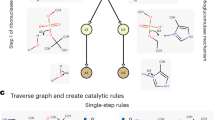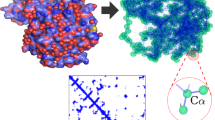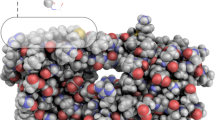Abstract
Despite the fact that the number of publications associated with the keyword 'enzyme' increases every year, the precise origin of enzyme catalysis has remained unresolved. Because of sustained intensive research efforts from an increasing number of laboratories, detailed information regarding the physics, chemistry and kinetics of enzymes is accumulating rapidly. The growing body of data contains many examples of kinetic behavior that are incompatible with a static view of enzyme catalysis. As a result, numerous laboratories are approaching the consensus that protein motion plays an essential role in enzyme catalysis. A model that incorporates nuclear quantum tunneling together with two classes of protein motion—termed conformational sampling (pre-organization) and reorganization—is recommended as a means of understanding the large body of data for enzyme-catalyzed hydrogen transfers. It should also serve as a vehicle for future efforts in the development of potent enzyme inhibitors and the de novo design of all classifications of enzymes.
This is a preview of subscription content, access via your institution
Access options
Subscribe to this journal
Receive 12 print issues and online access
$259.00 per year
only $21.58 per issue
Buy this article
- Purchase on Springer Link
- Instant access to full article PDF
Prices may be subject to local taxes which are calculated during checkout




Similar content being viewed by others
Change history
20 July 2009
In the version of this article initially published, in the first line on the right hand column of Box 2, the sentence began "The distance ro...," whereas it should read "The tunneling distance...." Also, reference 47 was omitted from the end of the second to last sentence of the legend of Figure 3. These errors have been corrected in the HTML and PDF versions of the article.
References
Pauling, L. Molecular architecture and biological reactions. Chem. Eng. News 24, 1375 (1946).
Blake, C.C.F. et al. Structure of hen egg-white lysozyme - a 3-dimensional Fourier synthesis at 2Å resolution. Nature 206, 757–761 (1965).
Monod, J., Wyman, J. & Changeux, J.P. On the nature of allosteric transitions - a plausible model. J. Mol. Biol. 12, 88–118 (1965).
Kaptein, R., Zuiderweg, E.R.P., Scheek, R.M., Boelens, R. & Vangunsteren, W.F. A protein structure from nuclear magnetic-resonance data - Lac repressor headpiece. J. Mol. Biol. 182, 179–182 (1985).
Cha, Y., Murray, C.J. & Klinman, J.P. Hydrogen tunneling in enzyme-reactions. Science 243, 1325–1330 (1989). This was the first clear demonstration of significant room temperature tunneling in an enzyme-catalyzed reaction.
Klinman, J.P. An integrated model for enzyme catalysis emerges from studies of hydrogen tunneling. Chem. Phys. Lett. 471, 179–193 (2009).
Jencks, W.P. Catalysis in Chemistry and Enzymology (McGraw-Hill, New York, 1969).
Pollack, S.J., Jacobs, J.W. & Schultz, P.B. Selective chemical catalysis by an antibody. Science 234, 1570–1573 (1986).
Hilvert, D. Critical analysis of antibody catalysis. Annu. Rev. Biochem. 69, 751–793 (2000).
Jäckel, C., Kast, P. & Hilvert, D. Protein design by directed evolution. Annu. Rev. Biophys. 37, 153–173 (2008).
Lin, H.N., Tao, H.Y. & Cornish, V.W. Directed evolution of a glycosynthase via chemical complementation. J. Am. Chem. Soc. 126, 15051–15059 (2004).
Griffiths, A.D. & Tawfik, D.S. Man-made enzymes - from design to in vitro compartmentalisation. Curr. Opin. Biotechnol. 11, 338–353 (2000).
Taylor, S.V., Kast, P. & Hilvert, D. Investigating and engineering enzymes by genetic selection. Angew. Chem. Int. Ed. 40, 3310–3335 (2001).
Röthlisberger, D. et al. Kemp elimination catalysts by computational enzyme design. Nature 453, 190–195 (2008).
Voigt, C.A., Gordon, D.B. & Mayo, S.L. Trading accuracy for speed: A quantitative comparison of search algorithms in protein sequence design. J. Mol. Biol. 299, 789–803 (2000).
McCammon, J. & Harvey, S. Dynamics of Proteins and Nucleic Acids, 234 (Press Syndicate of the University of Cambridge, New York, 1987).
English, B.P. et al. Ever-fluctuating single enzyme molecules: Michaelis-Menten equation revisited. Nat. Chem. Biol. 2, 87–94 (2006). Single-molecule Michaelis Menten kinetics demonstrated a large number of rate constants contributing to observed rate constant in bulk measurements.
Lu, H.P., Xun, L.Y. & Xie, X.S. Single-molecule enzymatic dynamics. Science 282, 1877–1882 (1998).
Pudney, C.R. et al. Mutagenesis of morphinone reductase induces multiple reactive configurations and identifies potential ambiguity in kinetic analysis of enzyme tunneling mechanisms. J. Am. Chem. Soc. 129, 13949–13956 (2007).
Liang, Z.X., Lee, T., Resing, K.A., Ahn, N.G. & Klinman, J.P. Thermal-activated protein mobility and its correlation with catalysis in thermophilic alcohol dehydrogenase. Proc. Natl. Acad. Sci. USA 101, 9556–9561 (2004).
Kohen, A., Cannio, R., Bartolucci, S. & Klinman, J.P. Enzyme dynamics and hydrogen tunnelling in a thermophilic alcohol dehydrogenase. Nature 399, 496–499 (1999). A thermophilic enzyme showed most efficient tunneling at elevated temperature. This stood in stark contrast to predictions that tunneling should become less important as temperature increases.
Maglia, G. & Allemann, R.K. Evidence for environmentally coupled hydrogen tunneling during dihydrofolate reductase catalysis. J. Am. Chem. Soc. 125, 13372–13373 (2003).
Heyes, D.J., Sakuma, M., de Visser, S.P. & Scrutton, N.S. Nuclear quantum tunneling in the light-activated enzyme protochlorophyllide oxidoreductase. J. Biol. Chem. 284, 3762–3767 (2009).
Eyring, H. The activated complex in chemical reactions. J. Chem. Phys. 3, 107–115 (1935).
Bell, R.P. The Tunneling Effect in Chemistry (Chapman and Hall, New York, 1980).
Garrett, B.C. & Truhlar, D.G. Criterion of minimum state density in the transition-state theory of bimolecular reactions. J. Chem. Phys. 70, 1593–1598 (1979).
Truhlar, D.G. et al. Ensemble-averaged variational transition state theory with optimized multidimensional tunneling for enzyme kinetics and other condensed-phase reactions. Int. J. Quantum Chem. 100, 1136–1152 (2004).
Glickman, M.H. & Klinman, J.P. Nature of rate-limiting steps in the soybean lipoxygenase-1 reaction. Biochemistry 34, 14077–14092 (1995).
Nesheim, J.C. & Lipscomb, J.D. Large kinetic isotope effects in methane oxidation catalyzed by methane monooxygenase: evidence for C-H bond cleavage in a reaction cycle intermediate. Biochemistry 35, 10240–10247 (1996).
Melander, L. & Saunders, W.H. Reaction Rates of Isotopic Molecules, 331 (Robert E. Krieger Publishing Company, Malabar, India, 1987).
Knapp, M.J., Rickert, K. & Klinman, J.P. Temperature-dependent isotope effects in soybean lipoxygenase-1: correlating hydrogen tunneling with protein dynamics. J. Am. Chem. Soc. 124, 3865–3874 (2002). A full tunneling model was derived from earlier work by Kuznetsov and Ulstrup (ref. 32 ) and used to reproduce temperature-dependent KIEs in soybean lipoxygenase.
Kuznetsov, A.M. & Ulstrup, J. Proton and hydrogen atom tunnelling in hydrolytic and redox enzyme catalysis. Can. J. Chem. 77, 1085–1096 (1999).
Meyer, M.P. & Klinman, J.P. Modeling temperature dependent kinetic isotope effects for hydrogen transfer in a series of soybean lipoxygenase mutants: the effect of anharmonicity upon transfer distance. Chem. Phys. 319, 283–296 (2005).
Hothi, P. et al. Driving force analysis of proton tunnelling across a reactivity series for an enzyme-substrate complex. ChemBioChem 9, 2839–2845 (2008).
Schramm, V.L. Enzymatic transition states: thermodynamics, dynamics and analogue design. Arch. Biochem. Biophys. 433, 13–26 (2005).
Saen-Oon, S., Quaytman-Machleder, S., Schramm, V.L. & Schwartz, S.D. Atomic detail of chemical transformation at the transition state of an enzymatic reaction. Proc. Natl. Acad. Sci. USA 105, 16543–16548 (2008).
Boehr, D.D., Dyson, H.J. & Wright, P.E. Conformational relaxation following hydride transfer plays a limiting role in dihydrofolate reductase catalysis. Biochemistry 47, 9227–9233 (2008).
McElheny, D., Schnell, J.R., Lansing, J.C., Dyson, H.J. & Wright, P.E. Defining the role of active-site loop fluctuations in dihydrofolate reductase catalysis. Proc. Natl. Acad. Sci. USA 102, 5032–5037 (2005).
Henzler-Wildman, K. & Kern, D. Dynamic personalities of proteins. Nature 450, 964–972 (2007).
Henzler-Wildman, K.A. et al. A hierarchy of timescales in protein dynamics is linked to enzyme catalysis. Nature 450, 913–916 (2007).
Min, W., Xie, X.S. & Bagchi, B. Two-dimensional reaction free energy surfaces of catalytic reaction: effects of protein conformational dynamics on enzyme catalysis. J. Phys. Chem. B 112, 454–466 (2008).
Saen-Oon, S., Ghanem, M., Schramm, V.L. & Schwartz, S.D. Remote mutations and active site dynamics correlate with catalytic properties of purine nucleoside phosphorylase. Biophys. J. 94, 4078–4088 (2008).
Kohen, A., Jonsson, T. & Klinman, J.P. Effects of protein glycosylation on catalysis: changes in hydrogen tunneling and enthalpy of activation in the glucose oxidase reaction. Biochemistry 36, 2603–2611 (1997).
Seymour, S.L. & Klinman, J.P. Comparison of rates and kinetic isotope effects using PEG-modified variants and glycoforms of glucose oxidase: the relationship of modification of the protein envelope to C-H activation and tunneling. Biochemistry 41, 8747–8758 (2002).
Tsai, S.C. & Klinman, J.P. Probes of hydrogen tunneling with horse liver alcohol dehydrogenase at subzero temperatures. Biochemistry 40, 2303–2311 (2001).
Wang, L., Goodey, N.M., Benkovic, S.J. & Kohen, A. Coordinated effects of distal mutations on environmentally coupled tunneling in dihydrofolate reductase. Proc. Natl. Acad. Sci. USA 103, 15753–15758 (2006).
Meyer, M.P., Tomchick, D.R. & Klinman, J.P. Enzyme structure and dynamics affect hydrogen tunneling: the impact of a remote side chain (1553) in soybean lipoxygenase-1. Proc. Natl. Acad. Sci. USA 105, 1146–1151 (2008). A distal mutation in SLO produced temperature-dependent KIEs. X-ray structures of the mutant enzymes showed no changes, implying that dynamical changes are required to account for the kinetic behavior.
Liu, H.B. & Warshel, A. Origin of the temperature dependence of isotope effects in enzymatic reactions: the case of dihydrofolate reductase. J. Phys. Chem. B 111, 7852–7861 (2007).
Roca, M., Messer, B., Hilvert, D. & Warshel, A. On the relationship between folding and chemical landscapes in enzyme catalysis. Proc. Natl. Acad. Sci. USA 105, 13877–13882 (2008).
Radkiewicz, J.L. & Brooks, C.L. Protein dynamics in enzymatic catalysis: exploration of dihydrofolate reductase. J. Am. Chem. Soc. 122, 225–231 (2000).
Truhlar, D.G. et al. Ensemble-averaged variational transition state theory with optimized multidimensional tunneling for enzyme kinetics and other condensed-phase reactions. Int. J. Quantum Chem. 100, 1136–1152 (2004).
Benkovic, S.J., Hammes, G.G. & Hammes-Schiffer, S. Free-energy landscape of enzyme catalysis. Biochemistry 47, 3317–3321 (2008).
Limbach, H.H., Lopez, J.M. & Kohen, A. Arrhenius curves of hydrogen transfers: tunnel effects, isotope effects and effects of pre-equilibria. Philos. Trans. R. Soc. Lond., B, Biol. Sci. 361, 1399–1415 (2006).
Zhang, Z.Q., Rajagopalan, P.T.R., Selzer, T., Benkovic, S.J. & Hammes, G.G. Single-molecule and transient kinetics investigation of the interaction of dihydrofolate reductase with NADPH and dihydrofolate. Proc. Natl. Acad. Sci. USA 101, 2764–2769 (2004).
Hammes-Schiffer, S. & Benkovic, S.J. Relating protein motion to catalysis. Annu. Rev. Biochem. 75, 519–541 (2006).
Wang, L., Goodey, N.M., Benkovic, S.J. & Kohen, A. The role of enzyme dynamics and tunnelling in catalysing hydride transfer: studies of distal mutants of dihydrofolate reductase. Philos. Trans. R. Soc. Lond., B, Biol. Sci. 361, 1307–1315 (2006). A distal mutation in DHFR led to temperature-dependent KIEs. This was surprising because of the distance between a relatively conservative M-W mutation and the active site of the enzyme.
Wolf-Watz, M. et al. Linkage between dynamics and catalysis in a thermophilic-mesophilic enzyme pair. Nat. Struct. Mol. Biol. 11, 945–949 (2004).
Gerhart, J.C. & Schachman, H.K. Allosteric interactions in aspartate transcarba-mylase 2. Evidence for different conformational states of protein in presence and absence of specific ligands. Biochemistry 7, 538–552 (1968).
Schnell, J.R., Dyson, H.J. & Wright, P.E. Effect of cofactor binding and loop conformation on side chain methyl dynamics in dihydrofolate reductase. Biochemistry 43, 374–383 (2004).
Marcus, R.A. & Sutin, N. Electron transfers in chemistry and biology. Biochim. Biophys. Acta 811, 265–322 (1985).
Pang, J.Y., Hay, S., Scrutton, N.S. & Sutcliffe, M.J. Deep tunneling dominates the biologically important hydride transfer reaction from NADH to FMN in morphinone reductase. J. Am. Chem. Soc. 130, 7092–7097 (2008).
Basran, J., Sutcliffe, M.J. & Scrutton, N.S. Enzymatic H-transfer requires vibration-driven extreme tunneling. Biochemistry 38, 3218–3222 (1999).
Harris, R.J., Meskys, R., Sutcliffe, M.J. & Scrutton, N.S. Kinetic studies of the mechanism of carbon-hydrogen bond breakage by the heterotetrameric sarcosine oxidase of Arthrobacter sp 1-IN. Biochemistry 39, 1189–1198 (2000).
Fan, F. & Gadda, G. An internal equilibrium preorganizes the enzyme-substrate complex for hydride tunneling in choline oxidase. Biochemistry 46, 6402–6408 (2007).
Swain, C.G., Stivers, E.C., Reuwer, J.F. & Schaad, L.J. Use of hydrogen isotope effects to identify the attacking nucleophile in the enolization of ketones catalyzed by acetic acid. J. Am. Chem. Soc. 80, 5885–5893 (1958).
Haslett, J.W. Translation of phase waves of de Broglie. Am. J. Phys. 41, 445 (1973).
Marcus, R.A. Theory of oxidation-reduction reactions involving electron transfer. 1. J. Chem. Phys. 24, 966–978 (1956).
Author information
Authors and Affiliations
Corresponding author
Rights and permissions
About this article
Cite this article
Nagel, Z., Klinman, J. A 21st century revisionist's view at a turning point in enzymology. Nat Chem Biol 5, 543–550 (2009). https://doi.org/10.1038/nchembio.204
Published:
Issue Date:
DOI: https://doi.org/10.1038/nchembio.204
This article is cited by
-
Acceleration of enzymatic catalysis by active hydrodynamic fluctuations
Communications Physics (2022)
-
Universality of fold-encoded localized vibrations in enzymes
Scientific Reports (2019)
-
The evolution of multiple active site configurations in a designed enzyme
Nature Communications (2018)
-
Rescue of conformational dynamics in enzyme catalysis by directed evolution
Nature Communications (2018)
-
Thermal activation of ‘allosteric-like’ large-scale motions in a eukaryotic Lactate Dehydrogenase
Scientific Reports (2017)



